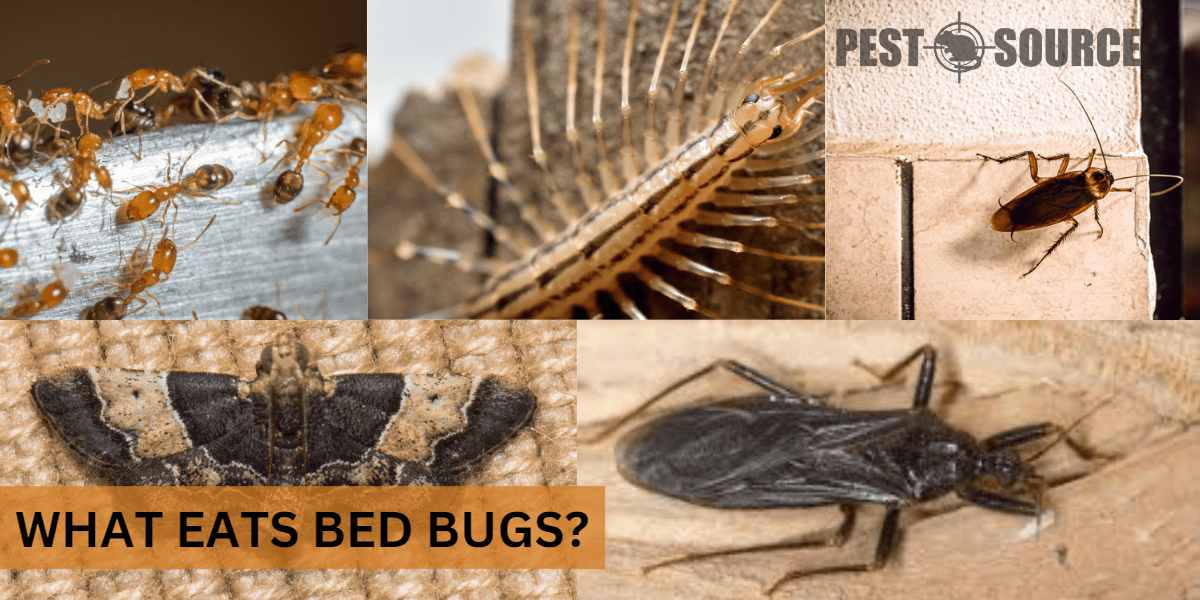Certain insects and animals, including spiders, cockroaches, and even some types of ants, are known to prey on bed bugs. Understanding the natural predators of bed bugs can offer insights into potential biological control methods. Dive into the article to learn about these natural bed bug enemies and their role in pest management.
POINTS
- While various insects and arachnids, such as Pharaoh ants, roaches, house centipedes, and masked hunters, are known to eat bed bugs, none of these are effective enough to significantly control or eliminate bed bug infestations.
- Despite consuming bed bugs, these predators can not be counted on to control large infestations. Spiders, specifically masked hunters, despite preying on bed bugs, can’t make a significant impact due to their low population and diverse diet.
- Larger animals, such as birds or mammals, don’t play a role in controlling bed bug populations as they’re neither their preferred nor regular meal.
- A common misconception is that bed bugs eat other insects like roaches. In reality, bed bugs only feed on blood from warm-blooded hosts and not on other insects.
- Pest control professionals, equipped with the right tools and expertise, remain the most effective solution for bed bug infestations. Prevention methods, including reducing clutter, encasing mattresses, and regular inspections, also play a key role in curbing these infestations.
The Predicament of Bed Bug Predation
When faced with a bed bug infestation, it’s natural to grasp at anything that may stop these pests, even their natural enemies. However, understanding bed bug predators isn’t as straightforward as you might think.
What are the common misconceptions about natural predators of bed bugs?
One common misconception is that you can simply introduce these critters in your home to eat away the problem. However, most of the time, these natural predators aren’t effective at controlling bed bug populations and can often exacerbate the issue.
What is the scope and significance of understanding bed bug predators?
Understanding bed bug predators helps us gain a holistic picture about the life cycle of these pests, the role they play in the ecosystem, and possible but only partially natural ways of dealing with infestations. However, this knowledge must be tempered with the reality that natural predation isn’t a magic bullet.
Do Cockroaches Eat Bed Bugs?
Cockroaches, dreaded as much as the bed bugs, have a contentious relationship with these pests.
Do roaches eat bed bugs?
Yes, American cockroaches, specifically, have been known to eat bed bugs. But take note, they aren’t the bed bug’s natural predators and it’s usually not their first choice of a meal.
Do cockroaches control bed bug populations or exacerbate the problem?
Despite their ability to eat bed bugs, cockroaches are not effective at controlling bed bug populations. In fact, they can make matters worse in two ways: roaches themselves are a pest needing their own methods of control, and they can spread bed bugs to other areas of a home.
Are there any differences between roaches and bed bugs?
While both are unwanted pests, there are significant differences. Roaches don’t bite humans like bed bugs do, but they do pose a health hazard due to their filthiness, possibly spreading bacteria and diseases.
Is there a link between the presence of roaches and bed bugs?
The presence of one doesn’t necessarily indicate the other. However, they both thrive in similar environments, so their coinciding presence could reflect broader issues, like bad sanitation.
The Role of Spiders in Bed Bug Control
Let’s move from roaches to spiders, which are known to have a more predator-prey relationship with bed bugs.
Do spiders eat bed bugs?
Yes, certain types of spiders, particularly the masked hunters, are known to eat bed bugs.
Do spiders effectively control bed bug populations?
While spiders do eat bed bugs, they can’t be counted on to efficiently control an infestation. In fact, the masked hunters needed to even make a small dent to a thriving bed bug population are usually not present in your average household or establishment.
What types of spiders prey on bed bugs?
Masked hunters are the primary spider species that prey on bed bugs. They are known for their stealthy hunting habits and distinctive appearance, hence the name.
Can masked hunters be considered as natural predators of bed bugs?
Technically yes. Masked hunters do prey on bed bugs. However, introducing them in your home won’t solve a bed bug problem due to their relatively low population and varied diet — remember, they eat more than just bed bugs.
Can Ants Contribute to Bed Bug Control?
From spiders, we turn to ants, a common household insect with a surprising connection to bed bugs.
Do ants, specifically Pharaoh ants, eat bed bugs?
Yes, Pharaoh ants are known to be attracted to bed bugs. They actively hunt them down, exhibiting predatory behavior.
Can ants play a role in reducing bed bug populations?
While ants, particularly the Pharaoh ants, eat bed bugs, they aren’t very efficient in controlling bed bug populations. You might see a small reduction in the number of bed bugs, but not nearly enough to tackle an infestation outright.
Understanding the Role of Centipedes and Other Insects
It’s time to look at house centipedes and a rather contemptuous insect, the stink bug, and their relations to bed bugs.
Do house centipedes eat bed bugs?
Indeed, they do! House centipedes are nothing if not versatile and will dine on various insects, including bed bugs.
Is there any known relationship between stink bugs and bed bugs?
Stink bugs and bed bugs are separate species with different behaviors and feeding preferences. They do not have any special interaction, although they can coexist in the same premises.
Do stink bugs eat bed bugs?
No, stink bugs and bed bugs belong to different feeding categories. While bed bugs are parasites feasting on blood, stink bugs mainly consume plant matter.
What other insects are known to consume bed bugs or their eggs?
Aside from the aforementioned masked hunters and centipedes, the larvae of the painted meal moth have been known to eat bed bug eggs.
Are these insects effective at controlling bed bug populations?
Similar to previous examples, while these insects do prey on bed bugs or their eggs, they are not highly effective at controlling or reducing robust bed bug populations.
Are There Other Animals That Eat Bed Bugs?
While the idea of larger animals munching on bed bugs might seem appealing, it’s not quite the full solution you might be dreaming of.
What animals eat bed bugs?
There are no known larger animals, like birds or mammals, that specifically prey on bed bugs.
What role do these animals play in controlling bed bug populations, if any?
Without any larger animals known to eat bed bugs, there’s unfortunately no significant role they play in controlling these infestations.
Do silverfish and crickets eat bed bugs, and what is their impact on bed bug populations?
These insects tend to feed on decaying plant material and are not interested in bed bugs. Consequently, they have no impact on bed bug populations.
Do the larvae of painted meal moths eat bed bug eggs?
Yes, the larvae of painted meal moths have been known to eat bed bug eggs. However, this does not make them effective at controlling overall bed bug populations.
Debunking Misconceptions about Bed Bugs and Their Predators
Let’s now break down some common misconceptions about bed bugs and their so-called “natural predators.”
Do bed bugs have any natural predators?
Yes, but with a big caveat. While several species do eat bed bugs or their eggs — such as masked hunters, house centipedes, or Pharaoh ants — none of these considerably decrease infestations or curtail growing populations.
Is there a natural predator of bed bugs that can be used effectively for pest control?
No, there’s no such magic creature that will solve a bed bug problem overnight. While various insects do eat bed bugs or their eggs, they cannot be relied upon as an effective pest control method due to their inability to make a significant dent in bigger infestations.
Do bed bugs eat other insects, like roaches?
No, bed bugs are strict hematophagous, meaning they feed on blood, specifically from warm-blooded hosts. Bed bugs do not eat other insects.



